Happy Sunday- I hope you all have a wonderful week ahead!
In case you missed it, I recently renamed Quarantine Creatives to Willoughby Hills. This newsletter will continue to explore topics like history, culture, work, urbanism, transportation, travel, agriculture, self-sufficiency, and more, just under a new name.
Thank you for your continued support! Now on with today’s edition.
What Is It?

What do you think you’re looking at here? These appear to be drinking glasses with a beautiful tulip pattern painted on them. Well, they are.
But they’re also something else. Something that today might be considered trash.
These glasses began life as containers for processed cheese purchased at the grocery store.
Kraft Foods called these jars “Swanky Swigs,” and they were in production from the 1930s through the 1970s. Originally made by the Hazel-Atlas Glass Company of Wheeling, West Virginia, these jars were even hand painted in the early days.
At the height of the Great Depression, Kraft realized that a jar that also made a decorative addition to the cupboard when empty might help sway a customer to buy their product. It was a gift with purchase promotion, except the gift was the purchase itself.

While Swanky Swigs were exclusive to Kraft, these reusable glass containers were also made by companies selling sour cream, mayonnaise, peanut butter, and jelly. The broader term for this category of reusable packaging was packers.
These days, much of the food we buy comes in plastic that gets discarded: jugs, cartons, clamshells, bags, films. It may be hard to imagine a time when packaging was considered worth saving. But grocery shopping just a few generations ago was very different than it is today.
Prior to the early 1900s, buying food involved bringing a shopping list to a clerk behind a counter. The clerk would retrieve the desired items and tally them.

In 1916, Piggly Wiggly started the precursor to the modern supermarket in Memphis. The store let shoppers freely browse, wandering up and down aisles selecting their own products. This design was quickly copied by grocers around the country, expanded and iterated with each new version.
Moving to self-service grocery shopping led to a greater focus on how foods were marketed and labelled, as Chester H. Liebs describes in his book Main Street to Miracle Mile:
“Realizing that supermarket shelves represented millions of feet of free exhibition space for their products, [manufacturers] became increasingly concerned about the way that consumers reacted to the sight of their merchandise. Companies redesigned their labels and redesigned their packaging for maximum appeal.”
There’s a pretty straight line that can be drawn between marketing cheese with painted flower jars and the explosion of ridiculously flavored snack foods that we see today. It’s all about tempting the consumer to make a purchase.
(Roy Wood Jr. posted a great video about the phenomenon of “Flaming’ Hot” foods for The Daily Show recently).
The manufacturing of jars that are also a drinking glasses were not just a Great Depression trend though. By the 1950s, the form had evolved to start targeting children born during the Baby Boom.
Welch’s began to sell their jellies in washable jars which featured popular cartoon characters and other designs that would appeal to kids in the early 1950s.
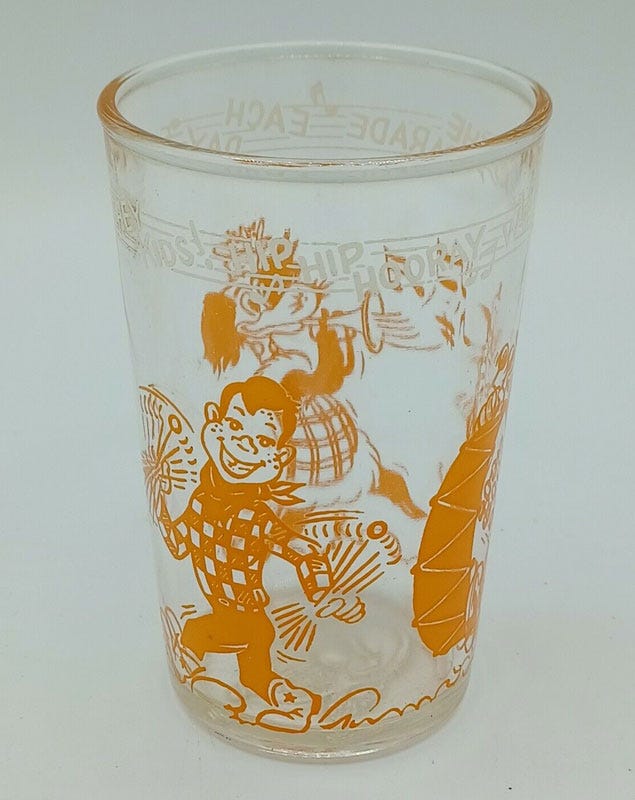
The first batch featured Howdy Doody, and it proved so popular that the line was expanded to later include characters from The Flintstones, Looney Tunes, and even Archie comics. (You can view the full list of Welch’s jar designs here).
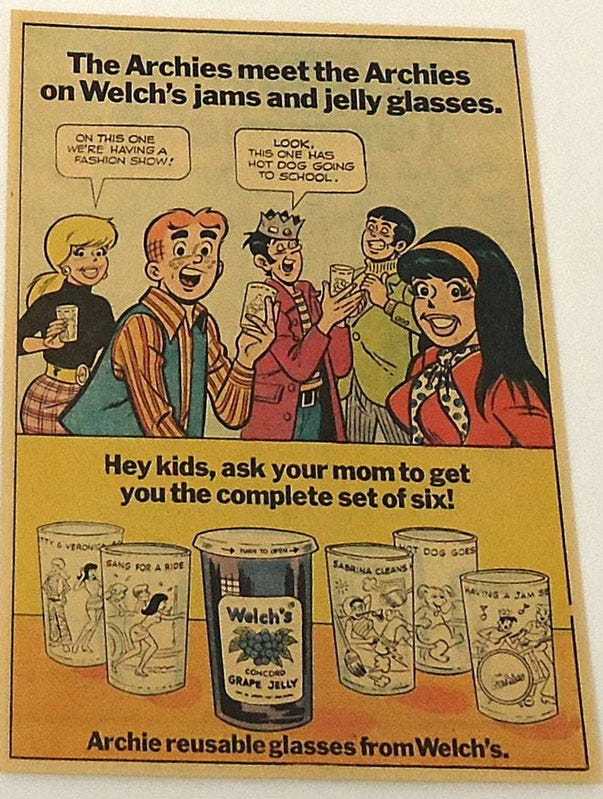
But by the late 1970s, these “packers” all but disappeared from store shelves. The competition from cheaper plastic containers may have played a part, but a change in the way glass was made was also cited as a culprit, as outlined in a Knight-Ridder article from 1989:
“‘What happened,’ said Dan Dillon, vice president for marketing at Welch's, ‘was a change in glass technology. The old mode of making glass, called full-press technology, became too expensive and was replaced by a new process, called press-and-blow technology. This new process produces a thinner glass.’
Alas, it was found that this new glass sometimes chipped when an old-style lid was pried off. And no food company would risk having that happen.”
Welch’s spent more than a dozen years looking for a way to bring back a jelly jar that could be reused as a drinking glass but posed no risk to the customer:
“The solution turned out to be a new type of plastic and metal lid that both vacuum seals the jelly and pops off with no danger of chipping the glass.”
In 1989, a new batch of jars was unveiled that featured dinosaurs. And not the popular Dinosaurs from the ABC sitcom, but cartoon renderings of semi-realistic dinosaurs:
“Dillon said the folks at Welch's advertising agency had suggested making up characters like a ‘graposaurus’ - but he vetoed that, insisting ‘kids want the real thing.’ And, because of that, he also was adamant that at least one of Welch's dinosaurs be ferocious-looking. ‘ . . .I made sure that the Tyrannosaurus rex was snarling.’"'
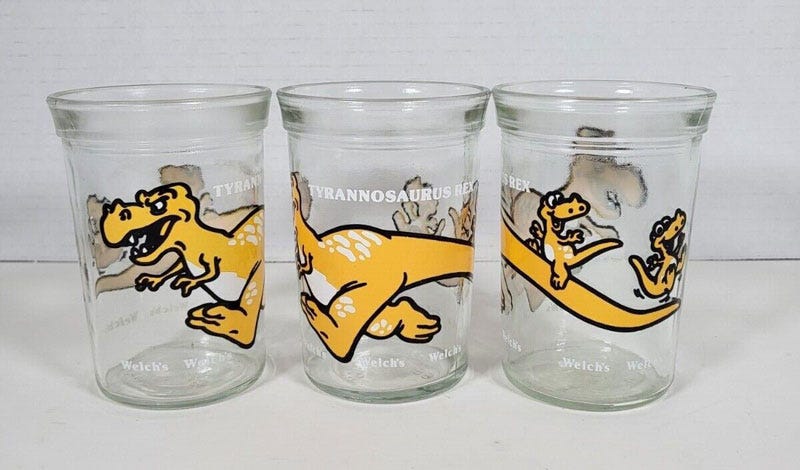
There were subsequent jars also inspired by nature, like two lines dedicated to endangered species in 1995 and 1996. Popular TV shows and movies also featured on the jars, including Pokemon, The Wubbulous World of Dr. Suess, The Lion King II: Simba’s Pride, and Muppets In Space.
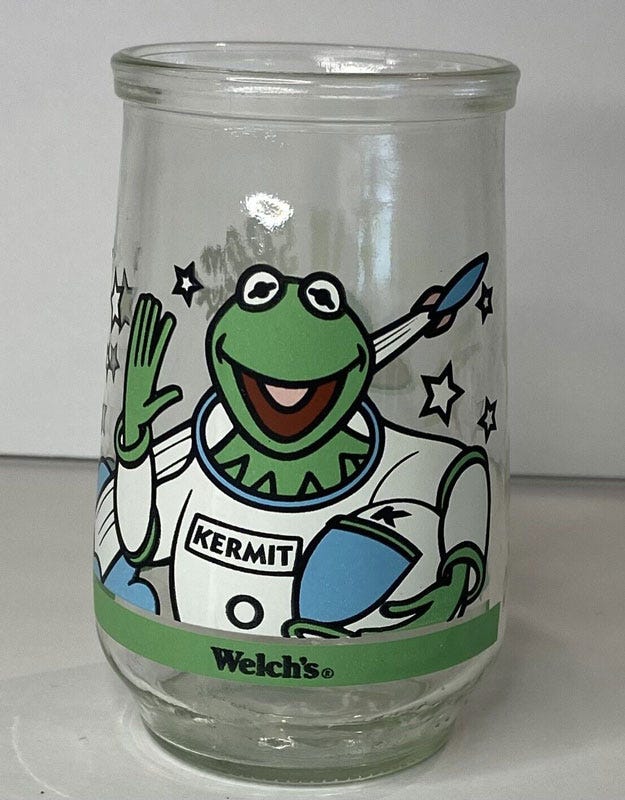
By the early 2000s, the packers disappeared from store shelves again, with no sign that they’re ever returning. I’ve reached out to Welch’s to see if these drinking glass jars might ever be revived, but I have not heard back.
I have written before about my admiration for items that do two or more things relatively well, which is really about being efficient with resources.
In the case of these packers, they were doing many things well. They were marketing a specific food product to a consumer on the shelves of a store. In some cases, they were also advertising something else, like a cartoon or movie. They were efficiently transporting a purchase from the factory to the store to the home. Then, they were living on as a useful drinking glass for years after the original product had been consumed. (The number of these jars still for sale on eBay and at garage sales and flea markets is a testament to their longevity.)
I imagine that there were thousands of homes in the middle of the twentieth century that had cupboards full of old jars and never even considered buying drinking glasses from a store.

I like that these packers placed an inherent value on the glass itself. We tend to mentally separate a drinking glass from a glass jar used to transport olives, pickles, or tomato sauce. But aren't they basically the same thing?
We would never consider putting a wine glass in the recycling bin after one drink, but we willingly discard nearly every jar after it is empty, even though they’re both made using basically the same materials and process.
But it doesn’t have to be like this. Glass jars can easily be washed and reused many times.
After seeing how Deb Perelman of Smitten Kitchen uses jars to organize dry goods in her pantry, I have placed a greater value on my used jars and save the good ones to store food. I like that they are airtight, making them better for storage than the packaging that comes from the store in many cases. Being made of clear glass also makes it easy to see the contents and quantity on hand at a quick glance.
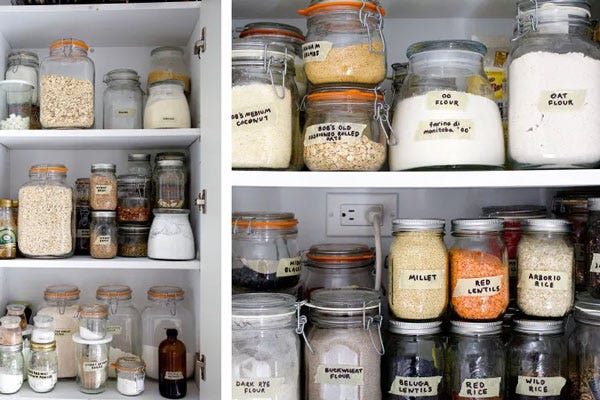
Finding reuse for old jars is a step in the right direction, but looking for ways to reduce the amount of materials we use for packaging is just as important.
According to the EPA, in 1960, about 100,000 tons of plastic containers came through our municipal waste systems. By 2018, that figure was 14 million tons, with more than 69% of that ending up in a landfill. Lots of the plastic was burned for power generation in incinerators.
In a new report, Greenpeace found that about 5% of our plastic containers are actually recycled, even if they are placed in blue bins by consumers. That percentage is falling as we produce more plastic and as less is able to be recycled. According to NPR:
“Waste management experts say the problem with plastic is that it is expensive to collect and sort. There are now thousands of different types of plastic, and none of them can be melted down together. Plastic also degrades after one or two uses. Greenpeace found the more plastic is reused the more toxic it becomes.
New plastic, on the other hand, is cheap and easy to produce. The result is that plastic trash has few markets — a reality the public has not wanted to hear.”
One option to reduce waste further is to sell items in bulk and allow customers to use their own containers. There’s a small grocer near us, Debra’s Natural Gourmet, which specializes in bulk products: nuts, rices, grains, pastas, spices, coffee, teas, and even cleaning products.
The store offers several options for packaging the bulk items, including paper bags and plastic tubs. But they also encourage customers to bring their own containers and have them weighed when empty to deduct the container weight from the purchase price.
This gets at the notion that Deb Perelman of Smitten Kitchen has in her pantry, but it cuts out the packaging in the middle that gets the item from the store shelf to her kitchen. In this case, the same glass jar can be refilled over and over without any additional packaging required.
(Here’s a video tour of the bulk wing of Debra’s Natural Gourmet (known as Debra’s Next Door) if you’re interested in seeing the setup:)
Had it not been for self-service supermarkets, the Great Depression, and later the Baby Boom, I’m not sure that packers would have ever hit the market. Had plastics come along a few decades earlier, packers might not have existed either.
I like how the need to market and sell products adapted to the thriftiness of those times, resulting in a win-win for everybody. The manufacturers had an attractive product, the supermarket made a sale, and the consumer walked away with something practical that could be used for a long, long time.
We may never see a jar of jelly or sour cream designed to be a drinking glass on store shelves again, but I hope that there’s an enterprising entrepreneur out there trying to come up with a sensible product that can reduce our waste, encourage reuse, and be recycled when it reaches the end of it’s life. Packers fit that bill, but maybe someday there will be another container that’s just as innovative to meet our current need.
Until then, I’ll be keeping a closer eye on thrift store shelves to see if I can score a cool vintage drinking glass with an interesting story behind it.
Random aside: With a name like “packers,” and the fact that many of these jars were used for cheese, it made me wonder if the Green Bay Packers name had any tie in to these jars. But it turns out, the football team was named after the Indian Packing company, which was a meat packing company in Wisconsin. They were the team’s first corporate sponsor way back in 1919 and the name stuck.
I’d love to hear your thoughts- please drop a comment below!
Related Reading
If you’ve missed past issues of this newsletter, they are available to read here.
If you enjoyed this issue, please share forward it to a friend or share it on social media:
Stay Safe!
Heath


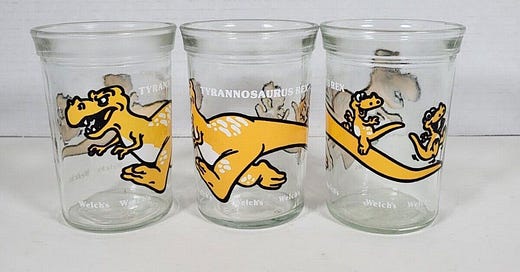



What a wonderful article, KUDOS for researching and writing it. I grew up with jelly glasses and used them for years after I had kids. I wish they would comeback too.
I fondly remember the Welch's jars from my childhood. I knew quite a few companies had jars like these because my grandparents were still using branded glass jars as drinking glasses when I was younger, too. It's actually a good thing they decided to get as artistic with them as they did, because so many are still in circulation today. I really wish we would go back to more glass containers. things don't taste the same with today's plastics and now that I think about it, who knows how toxic they've really become? With today's collectible market the way that it is, going back to these sorts of jars would actually benefit everything. The advertising potential alone is massive, as we have seen with movie tieins for many years. Great deep dive into how things used to be and still should be as usual!